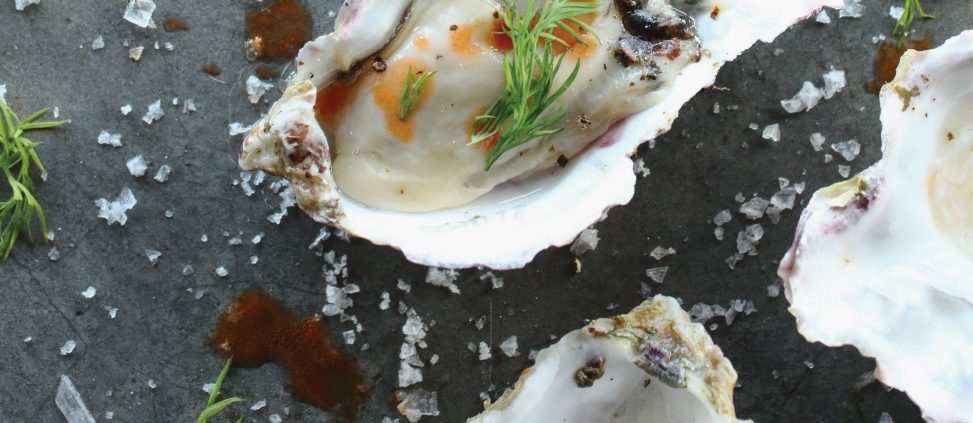Winter’s Bounty
by Mike Wagoner on February 2023 | Reprinted from Island Review
Hooray for the “R” months and the oysters they bring us. Oysters are among my favorite seafood delights. You might say that oysters are one of those foods that should just be savored … without putting too much analytical thought
into the juicy-goo of it. A wild and zany guy named Jonathan Swift (1667-1745) of Dublin, Ireland, once suggested: “He was a bold man who first ate an oyster.” Jeremy and Carol Stevens of Simply Oysters & Seafood in London, England, tell us that oysters have been around since the days when dinosaurs roamed – some 200 million years ago. “Archaeological evidence shows traces of scorch marks on ancient oyster shells consistent with fire,” according to the Stevenses. “This suggests that humans placed oysters on the embers of a fire or heated stones, and then cooked them for a few minutes until the oyster shells popped open.” “Jonathan Swift overcame his fear of oysters to become an enthusiastic advocate of oysters,” they said. “In Swift’s most famous book, ‘Gulliver’s Travels’ (1726), the main character became shipwrecked at Lilliput, where he collected and ate oysters on the beach.” “Swift even penned instructions on how to boil oysters: ‘Take oysters, wash their shells clean, then put the oysters into an earthen pot, then put the pot into a kettle of water, and let them
boil. Your oysters are boiled in their own liquor and not mixed with water.”
Christopher Joyce, science correspondent with National Public Radio, said the first “oyster dinner” by humans may have occurred in caves at Pinnacle Point on the southern coast of South Africa. He cited research conducted by Dr. Curtis Marean, an anthropologist at Arizona State University. Stuart Walton, a science writer in Brighton, England, said Dr. Marean’s findings may mean that oysters “actually saved mankind and hastened our evolution from beast to man.” “Was the first human to eat an oyster fearless or starving Neither,” Walton said. “Any revulsion for, or fear of oysters, is a modern construct from people who wear shirts, skirts and suits.
The reality is that our ancestors would have gorged themselves on oysters every chance they got.” “The oyster is one of nature’s most bountiful foods, rich in minerals, protein, vitamin D, zinc, iron and copper as well as possessing high levels of vitamin C, phosphorus, niacin and riboflavin. But it doesn’t stop there. They’re also rich in beneficial antioxidants, healthy cholesterol and omega-3 fatty acids. Besides, oysters are easy to harvest and so soft that they’re easy to eat for all age groups.” The Greeks and Romans considered oysters to be a delicacy. In Greek mythology, Aphrodite, the goddess of love and beauty, emerged from a foamy sea on an oyster shell. The Greeks became the first to cultivate oysters by scattering “broken pottery pieces where oysters grew to get the oyster babies to attach.”
During the 19th century, oysters were sold at every street corner in London. Oysters were also very popular with bars since they were seen as a cheap food to serve alongside liquor and beer. Such establishments came to be known as “oyster saloons,” and the popularity soon extended to America’s large northern cities. In the South, the term was “oyster house,” said Robert F. Moss of Charleston, S.C., an author of numerous books on Southern food and drink. “Being on the coast with an active port, Charleston was the heart of oyster-eating in the Carolinas before the Civil War,” Moss said. “Hundreds of bushels of oysters came into Charleston from
Beaufort, N.C.”
Oysters in English Literature
By the 1820s, an “Oyster Row” of restaurants in Charleston, S.C., was thriving. They were selling more oysters than beef steaks, according to Suzannah Smith Miles of Charleston Living Magazine. One of the major players was David Truesdell, an entrepreneur who had relocated from New York City. He ran the best “oyster house” in Charleston and also perfected oyster farming on 200 acres of land that he leased on nearby Sullivan’s Island close to Breach Inlet. The locals dubbed Truesdell as the “Oyster King.” Miles wrote: “He had shown that, with care, oysters could be developed, improved upon and raised with the same scientific experimentation that cotton planters used to develop a finer product.” “The unstoppable Truesdell accomplished what he set out to do. He made a tidy fortune through oysters. If one could give a fitting epitaph for this unique waterman, it would be that, indeed, ‘the world was his oyster.’”
Curiously, that phrase was coined by legendary British poet and dramatist William Shakespeare in “The Merry Wives of Windsor,” a comedy published in 1602. Ed Goldswain, who taught English literature for four decades in London, England, is a Shakespearian scholar. He explained: “‘The world is your oyster’ saying is often offered as encouragement to young people about to embark on adult life. It simply means that everything is open to them, and if one is lucky, he or she could encounter something special.” “If you have an oyster, there is a chance that there may be a pearl in it. A nice fresh oyster can be hard to open, but once opened, it’s good,” Goldswain said. “And perhaps it may have a pearl in it, which would be a valuable addition to one’s life.” “So when we set out to seek our fortune, the pearl is the good luck we may have. If we’re lucky we will find it,” Goldswain said. The odds of finding a natural pearl in an oyster are said to be 1 in 10,000. The odds of it being a pearl of gemstone quality are 1 in 1,000,000.
“Life can be hard, but if you keep at it, it will sometimes unexpectedly give you a reward,” Goldswain said. “That’s why
Shakespeare’s original quote ‘the world’s mine oyster’ has evolved into a favourite metaphor for life.” Getting back to Truesdell, his oyster farming operation was “pearl worthy,” wrote Robert F. Moss. “Borrowing techniques from rice planting, he built brick abutments with floodgates to control the flow of the tide into his beds, which allowed him to cultivate and harvest even during high tides. “Truesdell’s beds were a tempting target for poachers, and the oyster farmer was reported to have stood guard nightly over his crop with a blunderbuss and a brace of pistols.”
Oyster Experts Delve into the ‘R’ Month Rule of Thumb
Can you really only eat oysters in “R” months of September through April?
Southern Living magazine recently asked Sheri Castle of Chapel Hill, N.C., to check it out. She’s a highly respected cookbook author, recipe developer and cooking teacher. “The rationale behind skipping oysters during the warmest months was to avoid oysters that might not taste good or, even worse, be unsafe to eat,” Castle reported. “Back when we had only wild oysters, summertime was a factor on several fronts. Wild oysters spawn in the summer when the water is warmest.” “In many places, oyster season closed during that time period to give the oysters opportunity to reproduce, yielding a more generous and sustainable oyster harvest later in the year. Another factor is that spawning oysters are small, watery and have an unpleasant off-taste.” Christine Gallary of San Francisco, a contributor to the popular Kitchn food-focused website, drew a similar “R” month assignment.
Rowan Jacobsen, author of “A Geography of Oysters,” confirmed that when spawning, oysters tend to “get soft and rank.” He said that prior to refrigeration, “it wasn’t safe to eat raw animals in wooden barrels that had baked all day on the docks.” “Oysters have to be refrigerated the moment they come out of the water and stored at that temperature all the way to your plate,” Jacobsen said. “Most oysters still taste much better in fall and winter than they do in summer,” he said. “Oysters taste best out of cold water, so I say to follow the frost line – southern oysters in late winter and early spring, northern oysters in fall.” He encourages everybody to feel comfortable “eating oysters from anywhere” during the holidays – from Thanksgiving through New Year’s Day. Castle said that “times, and oysters, have changed, and now it’s perfectly all right to eat oysters in May, June, July and August. The United States has made huge strides in the safe and sustainable harvesting of oysters.” “The popularity and availability of farmed oysters has surged,” she said. “Cold water farms can produce edible oysters year-round. On farms in warmer waters, the oyster breeds are often triploids, which means they are sterile, similar to seedless fruits and vegetables. Oysters that never spawn cannot suffer the flavor and quality issues caused by summertime spawning.”
C.J. Husk, who is the brand ambassador and “oyster dude” at Island Creek Oysters in Duxbury, Mass., told Gallary that “these days, the ‘R’ in oystering stands for ‘refrigeration.’” Chris Sherman, company president at Island Creek, said the
best way to store raw, unshucked oysters at home is to place them in a bowl in the refrigerator. “Cover them with a damp dish cloth so they don’t dry out. They don’t have to sit on ice, but make sure the refrigerator temperature is around 38 or 39 degrees. For the best result, eat oysters within a week of harvest.” The old “R-Rule” is simply out of style, stated Tyler Chadwick of Carteret County, founder and owner of Carolina Gold Oyster Company, located north of Beaufort on Merrimon Road. Today’s technology and research have made it safe to consume oysters in the “non-R months.” “Let’s move into the now and future in the world of oysters. Enjoy oysters every month of the year,” he said. Ryan Speckman, a seafood distributor based in Raleigh, said what really seals the deal is that there’s been a tremendous upswing in the number of chefs who are willing to put oysters on their menus year-round.




